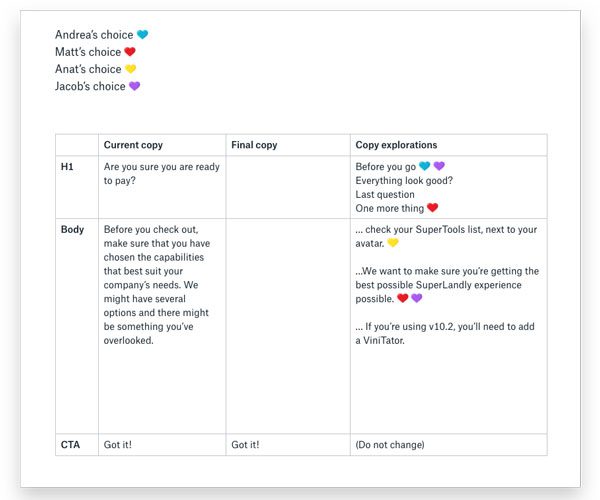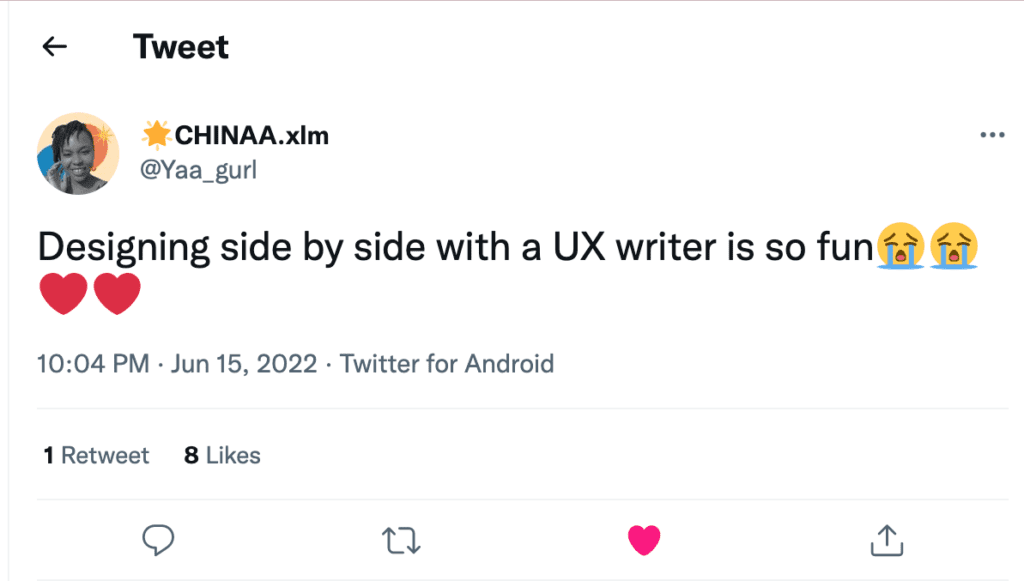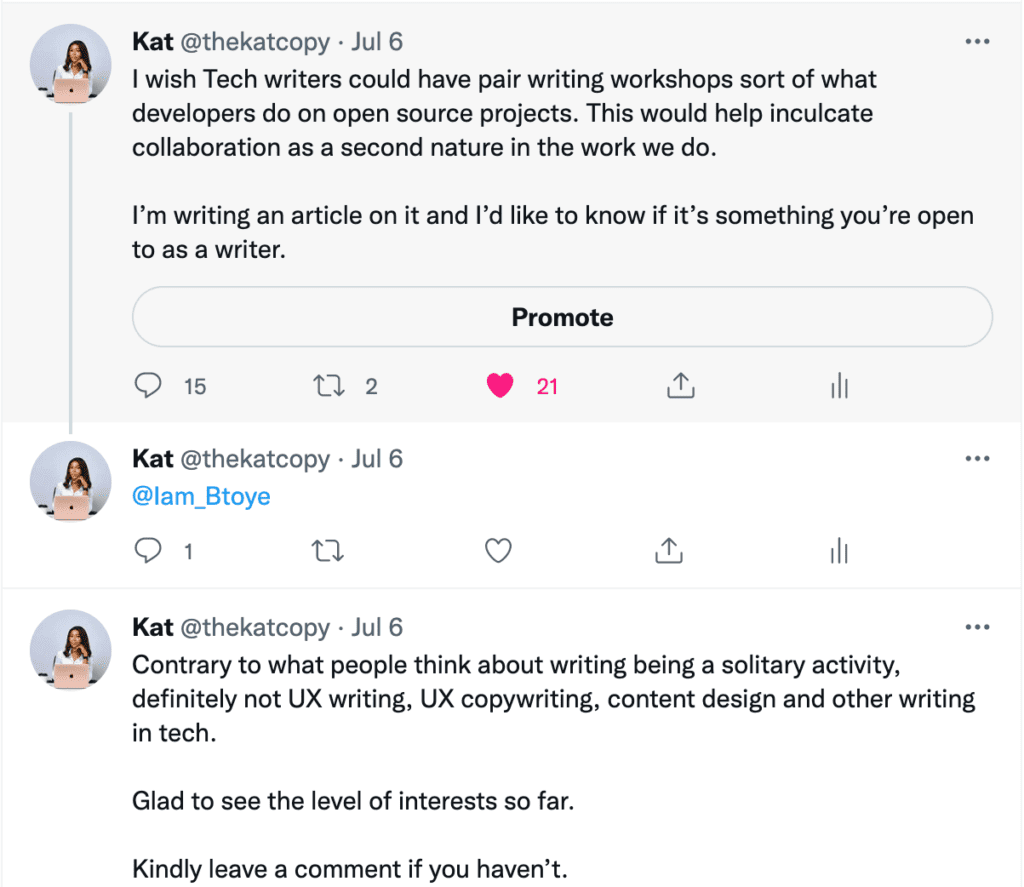How to be a better UX writer in 2022
How to be a better UX writer in 2022

The demand for the best UX writers for hire is rising due to the increased usage of digital products and services. These writers are responsible for humanizing the way technology interacts with users.
Maybe you’ve landed your seat on the product table or are still searching for your first UX writing Job.
Either way, the UX demand is becoming competitive. It would help to always be on top of your UX copywriting game to increase your chances of getting hired and staying hired.
In this article, I share 8 tips to help you become a better UX writer in 2022 to secure and maintain your UX writing job.
1. Be a co-designer
A writer is also a designer, a designer of words rather than of things.
– Don Norman
The practice of UX writing is called content design precisely for that reason.
Yet, If you’ve been in the industry long enough, you know how tech writers struggle to get a seat early at the product design table.
Nevertheless, content designers must live up to their names by advocating for themselves and offering to lead design efforts.
Here are a few ways to achieve this:
- UX copy is a design element. As a UX writer, you should learn how to use design tools like Figma to visualize, receive feedback, and iterate copy. Doing this would save time and boost efficiency.
- UX copy is an integral part of design systems, and learning the design lingo is a good start. One way to do this is to enroll in a design course ( like I did ) to learn how to solve design problems with design thinking. This would further enhance your communication skills when presenting these solutions to other team members.
- Just ask. UX copywriting is a collaborative job. Depending on your strengths or employer’s needs, you’ll likely work with designers, product managers, engineers, and marketers. Conversing with team members is essential to set yourself up for successful collaboration.
To begin, ask questions like:
- What are your experiences working with UX writers?
- If none. How have you handled UX copy for previous projects without a UX copywriter on the team? Any notable challenges?
- How might we work together to overcome these challenges?
Sometimes half of our challenges are resolved when we ask questions like this designer:

Converse more with designers to be a better UX writer, as seen in this tweet. You’d be surprised how readily available they are with answers.
2. Be a Collector
As writers, we collect words consciously or unconsciously through the content we consume.
The process of consciously collecting words directly from users’ conversations is called conversation mining, similar to keyword research in SEO copywriting.
However, the latter focuses on what people are searching for, while the former focuses on what people are discussing.
When mining conversations, a UX writer notes words and phrases with positive and negative connotations that would later influence a product’s overall content strategy.
Also, you want to document each piece of valuable words with links and screenshots as proof. You might be required to share these documents to validate your copy recommendations.
Don’t see this as too much work, but as a way to become the best at your work. After all, that’s what the article is about: How to be a better UX writer.
According to Adobe Content Strategy lead and hiring manager Andy Welfle, In his article on how to build a UX writing portfolio, he says
“UX writing (and other writing industries) requires a baseline level of strategy and decision-making”. Andy Welfle
With this in mind, you should always be able to show the rationale behind your choice of words, and effective copy management makes it a lot easier.
3. Be a Curator: Effective Copy Documentation
As I mentioned earlier, communicating your copy decisions is essential in your journey to becoming a better UX writer. To ensure a smooth workflow, you’ll need a system for organizing your content and copy explorations—a copy doc.
Stemming from the advertising world and adopted by the content design team at DropBox, Andrea Drugay shares how she creates, organizes, and shares all the copy in a project with team members using copy docs.
Instead of painstakingly moving from emails to slack, you can use design or word-processing tools like Airtable, Notion, or Google Docs to create copy docs for your next project.
Another significant benefit of effective copy management is that it helps solves the most dreaded UX problem- how to build a UX writing portfolio.
With an organized copy doc in place, you have a document to refer to when creating or updating your UX writing portfolio, even after the project has shipped.
When done well, they’ll keep you organized, make you look professional, and save you time and effort.
4. Be a better co-writer
We writers share similar quirks, like being alone with our thoughts and pen. Hence, people consider writing an all-around solitary activity, which isn’t the case with UX writing.
Content design involves collaboration. And it’s our job as UX writers to make it fun and flexible for the other team members.
Remember our copy docs? The good thing is we can share them with other teammates.
You can even take things further by practicing pair writing, a helpful tool writer and strategist Ove Dalen recommends:
Pair writing is a technique for collaborating on content in real-time. Instead of exchanging drafts or correcting with a red pen, two people sit down together to write.
Suppose you’re not together onsite. You can leverage video or audio calling platforms like Teams, or Google Meet, to communicate in real-time.
Pair writing with other team members can be a fun experience like we see this designer testify here:
And you know what’s more exciting? Other UX writers are similarly interested in trying this out.
Hopefully, we’d work towards a virtual pair writing workshop with other designers on an open-source project. If you’re interested in joining, you can follow me on Twitter and leave a comment indicating interest.
5. Be a Better Communicator
Yes, gathering feedback is faster and easier for everyone with copy docs and pair writing. But, you should tread carefully. Receiving comments in a doc is like a double-edged sword; a blessing and a curse—a blessing mostly, so relax.
However, you want to be graceful when receiving comments and feedback on these copy docs.
Here are a few ways to be a better communicator:
- When your copy recommendations are challenged, reference the data you gathered, as discussed in point three.
The more writers justify their content decisions with data, the more likely everyone gets on the same page.
- Communicate creatively. Online tools are constantly evolving and improving. Google docs now have an emoji reaction feature. As we see in Andrea’s document below, you can leverage them as communication tools.
A Dropbox document with emoji.
6. Stay Curious
“I have no special talents. I am only passionately curious”. Albert Einstein
Okay, Einstein, that’s an overdose of humility there. We know you’re special.
In truth, curiosity is a gift, one that’s freely given to writers. Show me a good writer who isn’t curious, and I’ll show you my room void of the sniffing whiskers of my curious cat.
The point is good writers are naturally curious. With the ever-evolving digital landscape, It sure pays to keep curiosity alive by staying up to date with trends and news while sharpening your creativity.
Here are a few ways to nurture your curiosity as a UX writer:
- Keep a swipe file. Snaps shots and journals are your BFFs. As you stroll online, take screenshots or document copy that inspires or intrigues you for further explorations and possible inspirations.
- Practice active listening even when you think you have an idea. Active listening helps you secure all the information you need during user interviews, surveys, research, or stakeholder meetings for product launches or upcoming events.
- Test things out. Remember the saying; curiosity kills the cat? Well, satisfaction brought it back, and that satisfaction results from testing.
UX writing is informed writing. Be curious about the performance of your copy. Create different copy variations and A/B test things out.
Content and user testing are huge parts of your job, and it’s always fulfilling to know that users are satisfied and you become a better UX writer.
- Read widely. Reading a wide range of materials is essential to cultivating creative ideas. Read books and case studies about marketing psychology. UX writing and marketing psychology are close relatives. You need to understand the users, what they want, and what drives them to purchase or use a product is necessary. You can dive deeper into user-centered design, usability, and accessibility, as Amos Adejimi advises:
Too busy to read?
Tune into podcasts to stay updated while on the go.
Here are some UX podcasts I listen to:
- Content rookie with Nicole Michaelis. My Friend, Ifeanyi, a UX writer at booking.com, was featured on this episode. I think it has useful advice, especially if you’re seeking junior UX writing roles.
- Writers in Tech by Yuval Keshtcher, founder of the UX Writing Hub
- The Content Strategy Podcast with Kristina Halvorson
7. Write – Always
Though an age-old tip, yet one you must follow if you wish to become a better UX writer.
Good UX writing is accessible and digestible. Making every word count is essential for UX writing.
“If you can’t explain it simply, you don’t understand it well enough”. Albert Einstein, physicist.
The more you practice, the better you will get at writing concisely. Practice describing a process or telling a story in brief paragraphs.
Alternatively, some experts say write as you talk. Please don’t. Because some spoken words, while conversational, may be difficult to read.
The idea is for you to personalize your copy and not to write how you actually talk, which would contain fillers like duh, ah, and uh…
In her book strategic writing for UX, Torrey Podmajersky advises writing conversationally in a text message conversation format, using side-by-side text bubbles.
Additionally, microblogging on Twitter helps me practice Torrey’s tip. Twitter has limited text field characters suitable for writing concisely.
8. Create a UX writing portfolio
Whether you’re a freelance UX writer for hire or a full-timer, you need a portfolio to demonstrate to potential employers that you can do the job.
Remember to keep your portfolio scannable and understandable. Your portfolio should assist your users: hiring managers, or business owners in achieving their goal of assessing your skills and experience seamlessly.
A good UX writing portfolio should include:
- Brief overview and scope of your UX writing samples.
- A summary of your UX writing process from ideation to implementation.
- Case studies of your work
Need a hand? Check out How to create a UX writing portfolio
Conclusion.
As big companies like Google and Apple continuously look for UX writers for hire, other companies are beginning to see the value of UX copywriting. Now is the best time to put these pointers to practice, become a better UX writer, and build a shiny UX writing portfolio that gets you in the door
Search

I’m Katherine Igiezele
A UX writer and SEO copywriter. I create copy that helps products engage with users and search engines for conversions. Want copy that users and Google would love? Get in touch.
Get proven writing and freelancing tips – biweekly.






1 thought on “How to be a better UX writer in 2022”
Pingback: My UI/UX Design Bootcamp Experience as a UX Writer – the lessons, wins, and the way forward. - katcopy